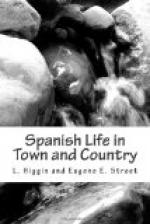The processions and functions of Holy Week and other fiestas have been so often and so fully described that there is no need to refer to them; but there are several curious survivals and religious customs in out-of-the-way places which seem to have escaped notice. I have not been able to find in any book on Spain a description of the strange dance which takes place in the cathedral of Seville on, I think, three days in the year, of which two are certainly the day of the Virgin and that of Corpus Christi. The origin of the dance seems to be lost, nor is its special connection with Seville known. All that one can hear of it is that one of the archbishops of Toledo objected to the dance as being irreverent and unusual, and ordered it to be stopped. The indignant people referred the matter to the Pope, but even the date of this appeal seems to be dubious, if not unknown. His Holiness replied that he could not judge of the matter unless he himself saw the dance. Accordingly, the boys who figure in this strange performance were taken to Rome, and they solemnly danced before the Pope. His verdict was that there was nothing irreverent about the dance, but he thought, as it was known only to Seville, it would be better eventually to discontinue it; but so long as the dress worn on the occasions when it is practised, lasted, the dance might continue. The dresses have lasted to the present day, and will always continue to last, say the Sevillanos, for as one part wears out it is renewed, but never a whole garment made. The dress is peculiar: it consists of short trousers to the knees, and a jacket which hangs from one shoulder, stockings and shoes with large buckles or bows, and a soft hat, somewhat of the shape of a Tam-o’-shanter, with one feather—that of an eagle, I think. The dress is red and white for the day of Corpus, and blue and white for the day of the Virgin, covered with the richest gold embroidery, for which Spain has always been famous. The boys, holding castanets in each hand, advance, dancing with much grace and dignity, until they reach the front of the High Altar; there they remain, striking their castanets and performing slow and very graceful evolutions for some time, gradually retiring again as they came in, dancing, down the nave. The boys are regularly instructed in the dance by the priests, and the number is kept up, so that neither dancers nor garments ever fail. The Pope’s order is obeyed, while the Sevillanos retain their strange religious function. The fact of the performance taking place in the evening perhaps accounts for its being so little known, but it would seem also as if the authorities of the cathedral do not care to have attention drawn to it. The dance is called los seises, and even the origin of the name is unknown.




